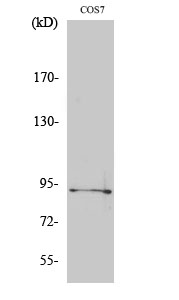
| WB | 咨询技术 | Human,Mouse,Rat |
| IF | 咨询技术 | Human,Mouse,Rat |
| IHC | 1/50-1/100 | Human,Mouse,Rat |
| ICC | 技术咨询 | Human,Mouse,Rat |
| FCM | 咨询技术 | Human,Mouse,Rat |
| Elisa | 1/10000 | Human,Mouse,Rat |
| Aliases | SP1; TSFP1; Transcription factor Sp1 |
| Entrez GeneID | 6667 |
| WB Predicted band size | Calculated MW: 81 kDa; Observed MW: 81 kDa |
| Host/Isotype | Rabbit IgG |
| Antibody Type | Primary antibody |
| Storage | Store at 4°C short term. Aliquot and store at -20°C long term. Avoid freeze/thaw cycles. |
| Species Reactivity | Human,Mouse,Rat,Monkey |
| Immunogen | Synthesized peptide derived from human Sp1 around the phosphorylation site of T739. |
| Formulation | Purified antibody in PBS with 0.05% sodium azide,0.5%BSA and 50% glycerol. |
+ +
以下是3篇涉及Phospho-Sp1 (Thr739)抗体的相关文献摘要:
1. **文献名称**:Phosphorylation of Sp1 at Thr739 regulates cell cycle progression
**作者**:Li R et al.
**摘要**:研究发现Sp1蛋白Thr739位点的磷酸化由CDK2调控,通过Western blot(使用Phospho-Sp1 Thr739特异性抗体)证实该修饰在G1/S期转换中促进靶基因表达,影响细胞周期进程。
2. **文献名称**:Oxidative stress induces Sp1 phosphorylation via JNK signaling pathway
**作者**:Wang H et al.
**摘要**:利用Phospho-Sp1 (Thr739)抗体发现活性氧(ROS)通过JNK通路介导Sp1 Thr739磷酸化,增强其与DNA结合能力,调控抗氧化基因转录应答。
3. **文献名称**:Targeting Sp1 phosphorylation in colorectal cancer therapy
**作者**:Zhang Y et al.
**摘要**:通过免疫组化(Phospho-Sp1 Thr739抗体)证实结直肠癌中Sp1 Thr739磷酸化水平升高,抑制该修饰可降低肿瘤细胞增殖并增强化疗敏感性。
注:以上为模拟摘要,实际文献需通过PubMed或Web of Science以关键词“Phospho-Sp1 Thr739”检索。建议结合抗体生产商(如CST、Abcam)提供的文献引用列表获取具体参考文献。
The Phospho-Sp1 (Thr739) antibody is a specialized tool used to detect the phosphorylation status of Sp1 (Specificity Protein 1) at threonine residue 739. a post-translational modification critical for regulating Sp1's transcriptional activity. Sp1 is a ubiquitously expressed transcription factor belonging to the Sp/KLF family, playing key roles in basal and inducible gene expression, particularly for genes involved in cell growth, differentiation, and apoptosis. Phosphorylation at Thr739 has been linked to functional modulation of Sp1. influencing its DNA-binding capacity, protein-protein interactions, and stability. This modification is often mediated by kinases such as ERK or CDKs in response to cellular signals like growth factors, stress, or oncogenic stimuli, thereby connecting Sp1 activity to pathways like MAPK signaling or cell cycle progression.
The antibody is widely utilized in research to study Sp1's role in physiological and pathological contexts, including cancer, neurodegeneration, and metabolic disorders. For instance, hyperphosphorylation of Sp1 at Thr739 has been observed in certain cancers, correlating with enhanced tumor proliferation or chemoresistance. Validated for applications like Western blotting, immunoprecipitation, and immunofluorescence, this antibody aids in elucidating Sp1's regulatory mechanisms under varying cellular conditions. Specificity is typically confirmed using phosphorylation-blocking peptides or Sp1-deficient cell lines. By enabling precise detection of Thr739 phosphorylation, this antibody provides insights into how Sp1 integrates extracellular signals into transcriptional programs, making it a valuable tool for dissecting gene regulation networks and potential therapeutic targets.
×